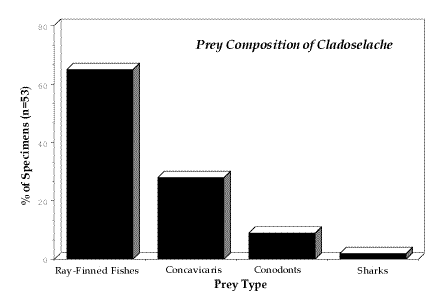Feeding Habits of Cladoselache
Because of their characteristic cartilaginous skeleton, sharks have very few hard parts that can fossilize. Usually, mineralized teeth, scales, and fin spines are all that survive. Occasionally, shark vertebrae or crania are also preserved, and - very exceptionally - faint hints of soft tissues.
The 'Cleveland Shale' on the south shore of Lake Erie have provided paleontologists with some of the most remarkable - and fortunate - geological accidents ever: about 100 specimens of a 370-million-year-old, 4-foot (1.2-metre) long shark called Cladoselache, some of which are so exquisitely preserved that not only teeth and fin spines, but also jaws, crania, vertebrae, muscle fibers, and even kidney tubules are discernible to varying degrees.
These extremely well-preserved Cladoselache specimens support the notion - inferred from its tail shape - that it was a fast-swimming hunter. Paleontologist Mike Williams has studied many of the superbly preserved fossil specimens of Cladoselache excavated from the Cleveland Shale. Astonishingly, 53 of these specimens had identifiable traces of their last meal preserved in their gut regions. These allowed Williams to glean some insights into the predatory habits of Cladoselache. He found that 65% of specimens examined had eaten small ray-finned bony fishes, 28% shrimp-like Concavicaris, 9% conodonts (peculiar hagfish-like proto-vertebrates with complex, comb-like teeth), and one specimen had eaten another shark. (These percentages add up to more than 100 because some specimens had eaten more than one kind of prey.)

The orientation of food items in the body cavity suggests that Cladoselache was swift enough to catch its prey on the fin. Its teeth were multi-cusped and smooth-edged, making them suitable for grasping but not tearing or chewing. Cladoselache therefore probably seized prey by the tail and swallowed it whole.
There may have been another reason for Cladoselache to adopt a high-speed lifestyle. It shared the Devonian seas with Dunkleosteus, a 20-foot (6-metre) long predatory placoderm with huge teeth and massive, heavily armored jaws (reminiscent of the thoroughly unpleasant creature from the Alien movies with fins - only 2.5 times as big). If such a monster isn't a selective pressure for the development of efficient swimming, I don't know what is

Dunkleosteus
Note: the Cleveland Shale also contains fossilized remains of Ctenacanthus and Stethacanthus
